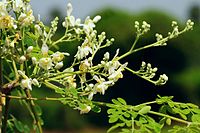
Photo from wikipedia
Herbal extracts are gaining widespread acceptance as ingredients in cosmetic and health products. Moringa oleifera Lam. is an interesting candidate as it has multiple biological properties. However, methods for quality… Click to show full abstract
Herbal extracts are gaining widespread acceptance as ingredients in cosmetic and health products. Moringa oleifera Lam. is an interesting candidate as it has multiple biological properties. However, methods for quality control of the use of M. oleifera are still required. This study proposes the use of isothiocyanate compounds and astragalin as chemical markers to standardize M. oleifera extracts. Both of these compounds are known to have anti-inflammation properties, and astragalin is also reported to have antioxidant properties. The HPLC-based cyclocondensation method was further developed and validated specifically for quantitative analysis of the isothiocyanate compounds in the M. oleifera extracts, and the concentration of astragalin in the M. oleifera extracts was determined by the HPLC method. Both methods gave acceptable linearity, accuracy, and precision with the limit of detection of 0.13 μg/ml for total isothiocyanate and 0.10 μg/ml for astragalin. The uses of the methods were demonstrated in the analyses of the components in the extracts taken variously from the leaves, immature seeds, mature seeds, petioles, and pods of the M. oleifera tree. Our results suggest that the methods developed could be used in the quality control of M. oleifera extracts to develop cosmetic and natural health products.
Journal Title: Scienceasia
Year Published: 2017
Link to full text (if available)
Share on Social Media: Sign Up to like & get
recommendations!